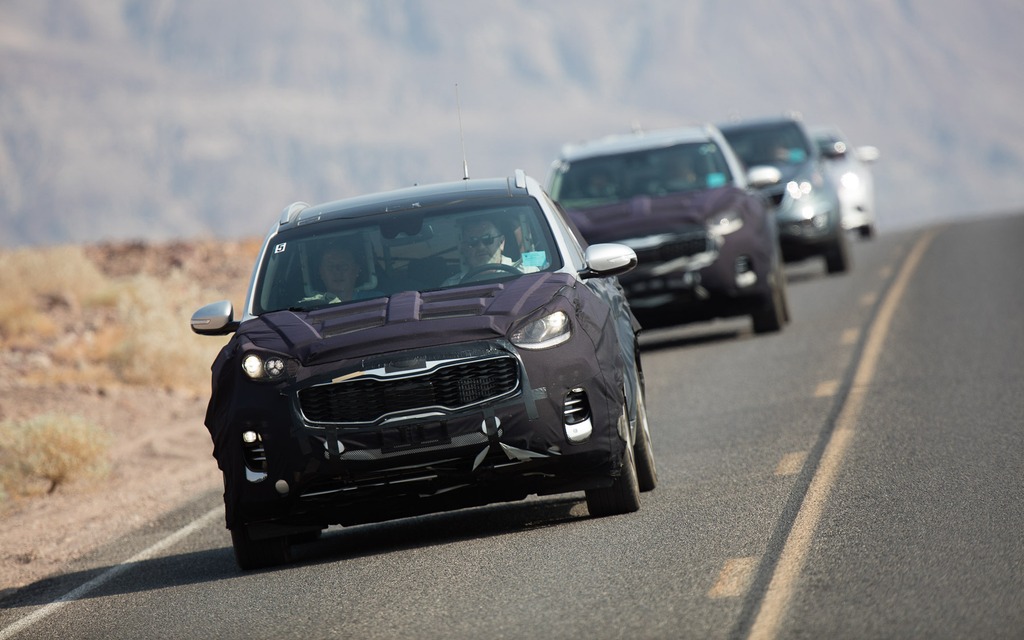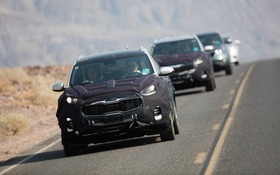2017 Kia Sportage: Maturity Kicks In

| Strong points |
|
|---|---|
| Weak points |
|
DEATH VALLEY, California – Most launches we get invited to emphasize the redesigned car or truck’s power, style and technology. We’ll drive the vehicle on windy roads or a racetrack in order to determine how well it handles. However, for the next-generation of the Sportage compact crossover, we got to discover how effective its A/C system is.
Mind you, this was not an ordinary press event. Only a few select publications from around the world had the opportunity to drive through Death Valley in California behind the wheel of the all-new 2017 Kia Sportage while it was still in its final stages of development. Including us.
With outside temperatures reaching 125 degrees Fahrenheit – that’s 52 Celsius – on the day we crossed this immense stretch of the Mojave Desert, the Sportage’s climate control system really came in handy. Like many manufacturers that hot-weather test their vehicles in Death Valley, Kia was busy collecting data on their crossover to make sure it performs as it was designed, even in the roughest of climates.
The Korean brand didn’t try to sell us the Sportage’s looks, because the pre-production examples we drove were heavily camouflaged as to not ruin Kia’s official unveiling of the crossover. In a market currently dominated by small utility vehicles, including the Honda CR-V, the Toyota RAV4, the Ford Escape and the Mazda CX-5, this Kia has to make a big splash to get more attention.
For the 2017 Sportage, wheelbase and length have increased by 30 and 40 mm respectively, but width and height are unchanged. While the previous-generation Sportage stood out with its stubby shape, high beltline and small window surface, the new CUV builds on that design with more detail and sophistication. The headlamp clusters have been disconnected from the grille and placed higher up on the front end, while the vehicle’s flanks and butt boast more muscular lines, as if the Sportage had decided to start heading to the gym. The rear window is now 30 mm taller and the rear pillars are narrower; however, the slim fenestration remains, which will continue to limit outward visibility, especially when backing up.
The interior has been updated as well. As in other new Kia products, the switchgear is simplified with a straightforward button layout on the centre stack and a few buttons on the centre console as well. The steering wheel has also been reshaped and the company’s UVO infotainment systems with seven- and eight-inch touchscreens are on board, too. Overall, the dashboard isn’t as bulky as before, and combined with the increased legroom afforded by the wheelbase stretch, the extra space means that front-seat passengers will feel less cramped. At the rear, two occupants will be at ease with more headroom while three will rub shoulders, a typical compact crossover trait. Cargo space grows from 465 to 503 litres with the rear seatback in place, and the liftover height has been lowered by 47 mm.
Uplevel versions of the 2017 Kia Sportage that we drove included niceties such as a panoramic sunroof, heated rear seats, ventilated front seats, a heated steering wheel, dual-zone climate control and navigation. The usual plethora of electronic safety aids are now available, including autonomous emergency braking, lane departure warning and lane keep assist as well as blind spot detection with rear cross traffic alert.
As before, front-wheel and all-wheel-drive versions of the Sportage will be offered. The base engine will be a 2.4-litre four-cylinder unit that develops about 180 horsepower, mated to a six-speed automatic. It provides zippy performance, but did feel a little strained during acceleration with four adults on board. For most small families, the 2.4L engine will do the job nicely.
Those in need of more power will still be able to choose the turbocharged 2.0L four that punches out about 245 hp, and is also connected to a six-speed automatic. A 175-hp, turbo 1.6L four that was added to the 2016 Hyundai Tucson is also offered in the Sportage, but the Canadian market will not get it for the time being. We don’t have any fuel economy figures to report yet, but we’re expecting marginal improvements.
The biggest difference between the 2017 Kia Sportage and the previous-generation model, which we drove back-to-back, is ride quality. The new Sportage feels much more refined than before, especially in the way the suspension handles bumps and road imperfections. There’s also less suspension noise, likely due to improved bushings and better cabin insulation. On the straight and uneventful roads crossing Death Valley, the difference isn’t so great; however, when we tackled the off-road course at Hyundai and Kia’s Proving Grounds in California aboard both generations of the CUV, the new model didn’t waste any time demonstrating its newfound refinement.
On the other hand, the new Sportage’s steering system hasn’t improved, and its on-centre feel is actually vague compared to the old model’s setup. In short, unless the company performs some last-minute tweaking, the 2017 Sportage won’t be more fun to drive than its predecessor, not that it needs to be.
Overall, the new generation is now more mature, more spacious, more stylish and benefits from plenty of new features. The previous Sportage represents 15% of Kia’s global sales, so the new one has big shoes to fill, but that shouldn’t be a problem. After our excursion through Death Valley, we can also attest that the climate control system works just fine. The 2017 Kia Sportage will be on sale in the spring of 2016.











